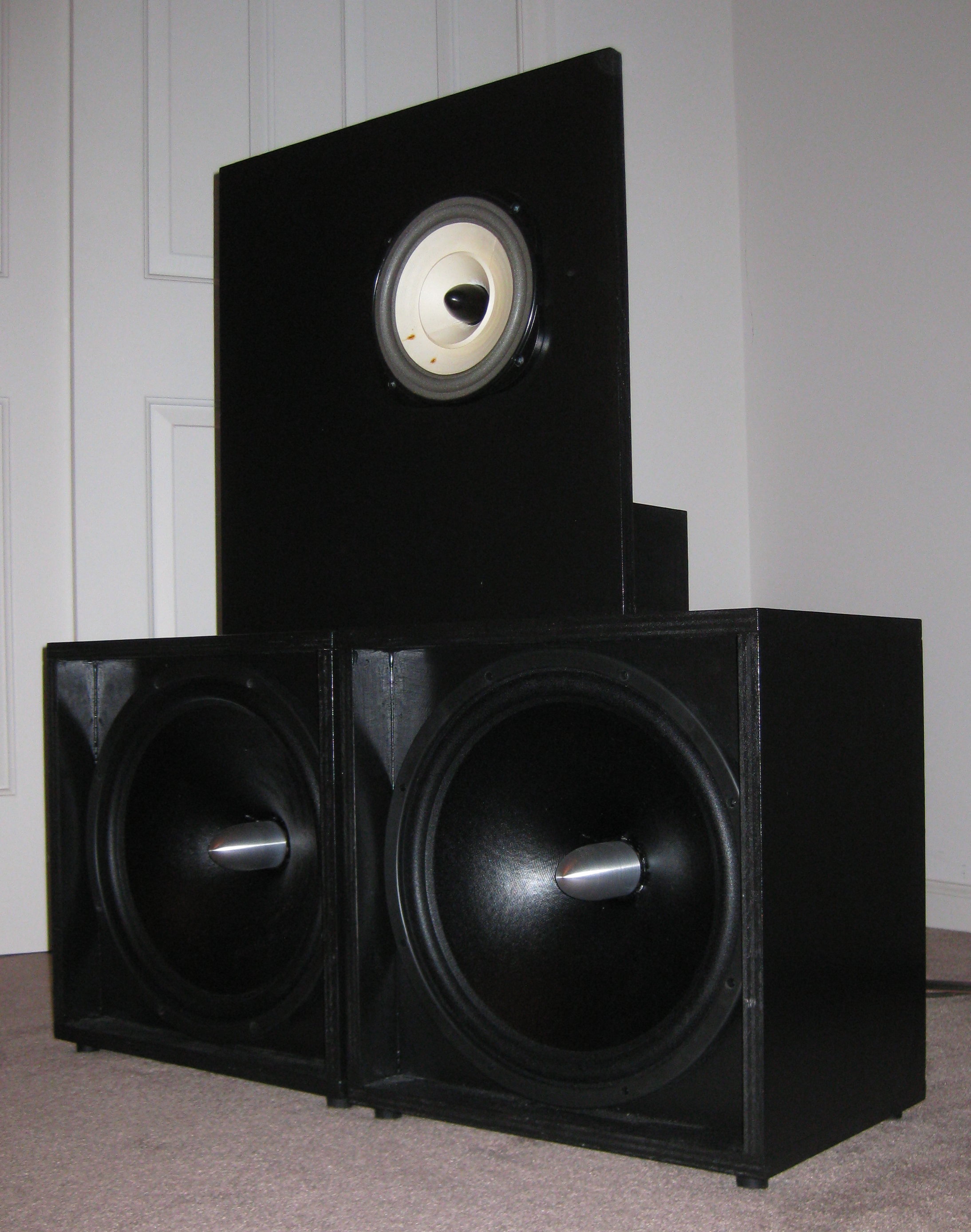

The biggest challenge faced by full range driver enclosure designers is producing enough bass output to match the rising midrange response typically generated by an efficient full range driver. If the designer is really serious about using only one driver, without any passive circuit elements between the driver and the amplifier, to cover the entire audio spectrum then in most cases a hybrid transmission line / back loaded horn enclosure is required. Getting a hybrid transmission line / back loaded horn enclosure to perform well is not a trivial task. If a passive correction circuit (really a modified BSC circuit with additional midrange attenuation) is acceptable to the designer then a resonant style of enclosure, a bass reflex enclosure or some form of quarter wave enclosure, can be used to produce a balanced SPL response at the expense of some loss of efficiency.
An alternate full range driver design approach introduces a second driver into the system, a large diameter high efficiency woofer (usually a professional audio model) to produce the demanding bass frequencies allowing the full range driver to cover the remaining majority of the audio spectrum where its real strength lies. This is an appealing idea since the large excursions required to produce significant bass output are removed from the full range driver. A few years ago I decided to try this approach and have since built several dipole speaker systems based on this concept.
Shown below is my first Lowther based OB speaker system built in 2005. I built a 60 inch wide open baffle with wings that could be folded back to reduce the front baffle width to a more manageable 24 inches. Even with the wings folded back the dipole speakers were still quite large. The retractable wings allowed me to get behind the speakers to access the wiring and power cords for the active crossover and a pair of power amps. Since this was more or less an experiment, I painted the baffles white to match the wall color. My goal was to have the speaker blend into the room and not be so noticeable, it didn't work.
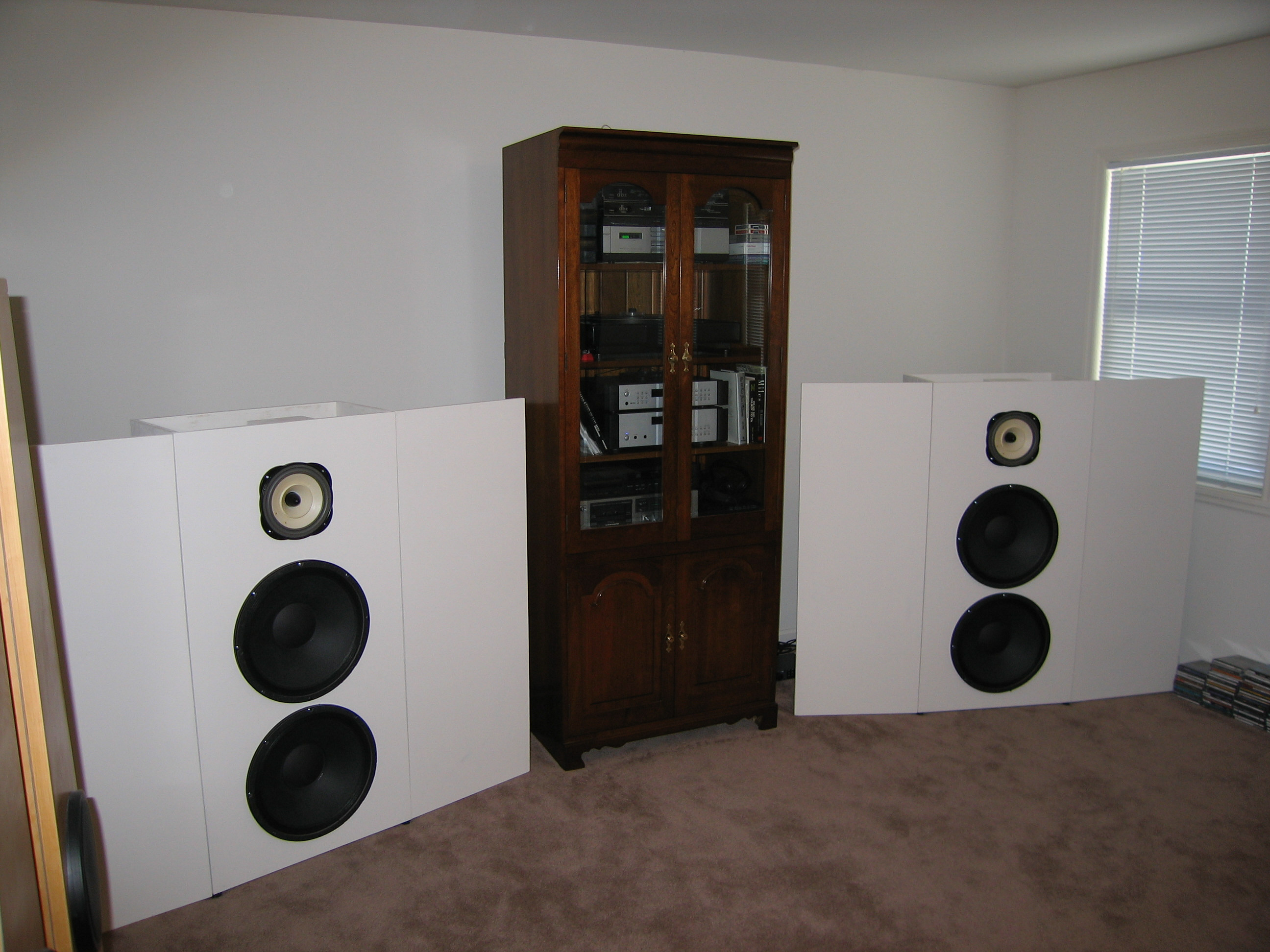
These large Lowther two way OB speakers lived in my listening room for several years and were praised by everyone who visited to hear the system. The Lowther sound was coupled with solid and deep bass produced by four Eminence Alpha 15A woofers. It not only filled the room with great sound, it physically filled the room with a solid wall of plywood when the wings were rotated out to be flush with the front baffle. Once positioned in the room, these speakers were so heavy they never moved for almost three years while serving as my reference speaker system. Moving them out of the way to try another set of speakers was out of the question. At some point this arrangement could not continue and in 2008 they were disassembled and replaced with a series of much smaller dipole speaker systems.
Memories of that first Lowther OB speaker stayed with me for the past 5 years and I kept promised myself to revisit the concept but with something of a more manageable size. I really like Lowther full range drivers, some people hate them but I have always been drawn to the sound. What follows is the result of about three years of starts, stops, tangents, and working on numerous other dipole concepts before arriving at the design shown at the top of the page. I had not realized it had been a three year effort but I think the wait was worth it.
In my original Lowther OB speaker system I used four of the modestly priced Eminence Alpha 15A woofers. I consider the Eminence Alpha 15A a great candidate for a dipole speaker system because of its 40 Hz fs, Qts of 1.3, efficiency of 92.5 dB/W/m, and affordable cost. In an infinite baffle this means that the SPL response is fairly flat as you descend from 100 Hz down to 40 Hz, there is a small pronounce hump at fs, and then the response drops at 12 dB/octave. This is not a great SPL curve for a boxed speaker since the bass time response will ring. But when you combine this driver with a 20 inch wide baffle's dipole response, which exhibits a 6 dB/octave low frequency roll-off, the resulting system SPL response looks really good for a bass system extending down to 40 Hz. For these types of designs, I like to use a 12 dB/octave low pass crossover between 100 and 200 Hz to further flatten the dipole bass response and smoothly transition to a full range driver. The Eminence Alpha 15A is a very flexible and affordable driver that works really well in almost any size OB, U frame, or H frame dipole speaker system.
For this new system I decided to step up to probably the best dipole woofer money can buy, the Acoustic Elegance Dipole 15. I ordered four of these drivers and a few weeks later they arrived. The Acoustic Elegance Dipole 15 is the work of a real craftsman with a machined cast frame, a huge magnet, and a stiff paper cone with a large silver phase plug at the center. However, the Acoustic Elegance woofers presented a different crossover challenge compared to the Eminence Alpha 15A woofers. The Acoustic Elegance Dipole 15 woofer has a lower fs of 22 Hz and a Qts of 0.8 which when combined with a 12 dB/octave low pass crossover, my standard recipe for the Alpha 15A woofers, results in a rolled off low frequency response which does not reach very deep. The 6 dB/octave dipole roll-off starting above 100 Hz really attenuates the deep bass output, the dipole response has rolled off the woofer's bass output by 12 dB by the time you get down to 25 Hz (two octaves below 100 Hz). My solution was to use a 6 dB/octave low pass filter set to about the driver's fs to counter the dipole roll off yielding a flat low frequency response. So far so good but nothing is ever without a trade-off, the penalty is that this crossover configuration also lowers the SPL/W/m output to about 83 dB for a pair of Dipole 15 woofers wired in parallel. The Acoustic Elegance drivers are not so efficient to start with at about 90 dB/W/m, so you need to use an active crossover to boost the low end to match the output of the Lowther full range driver which has an SPL/W/m of about 97 dB.
I looked at a lot of configurations for OBs, U frames, and H frames keeping in mind that I wanted a flexible system that could be repositioned and paired with different full range drivers pulled from my growing collection. Building four U or H frames seemed to make the most sense and I ended up compromising and building an offset H frame that is probably closer to a U frame design. The H frames are 11.75" deep and 17.25" square (outside dimensions) with the baffle offset back two inches from the front. The offset is intended to provide some protect for the Acoustic Elegance woofer's cone. Each Acoustic Elegance Dipole 15 woofer had its dual voice coils wired in series and then the pair of H frames per channel were connected to the amplifier in parallel. The active crossover applied a 6 dB/octave low pass filter set at 30 Hz and then boosted the power to the paralleled Acoustic Elegance woofers by 18 dB. The H frame's calculated SPL response matches the Lowther driver's SPL/W/m and is flat with -3dB points at 25 Hz and 240 Hz.
The Lowther PM2C drivers were placed in an OB that sits on top of the pair of H frames. The baffle is made from a twenty inch square panel with the driver center located twelve inches from the bottom and 13 inches from the outside edge to generate unequal path lengths to each side of the baffle geometry. I started with the Lowther PM2C drivers and a 12 dB/octave LR high pass crossover filter at 200 Hz. The final acoustic crossover from the Dipole 15 woofers to the Lowther PM2C full range drivers occurs slightly above 300 Hz. In the future, I plan to substitute pairs of my other Lowther A and DX series drivers into this same baffle.
The MathCad model for this design is shown below in Figure 1. The complete simulation of this Lowther open baffle speaker system is linked as a pdf file of the MathCad worksheet. The crossover settings and calculated system SPL response are copied and shown in Figure 2. This worksheet is a version of the default H frame two driver worksheet that can be downloaded from the Upgraded MathCad Computer Models page found elsewhere on this site. Pictures of the as built system are shown in Figures 3 and 4.

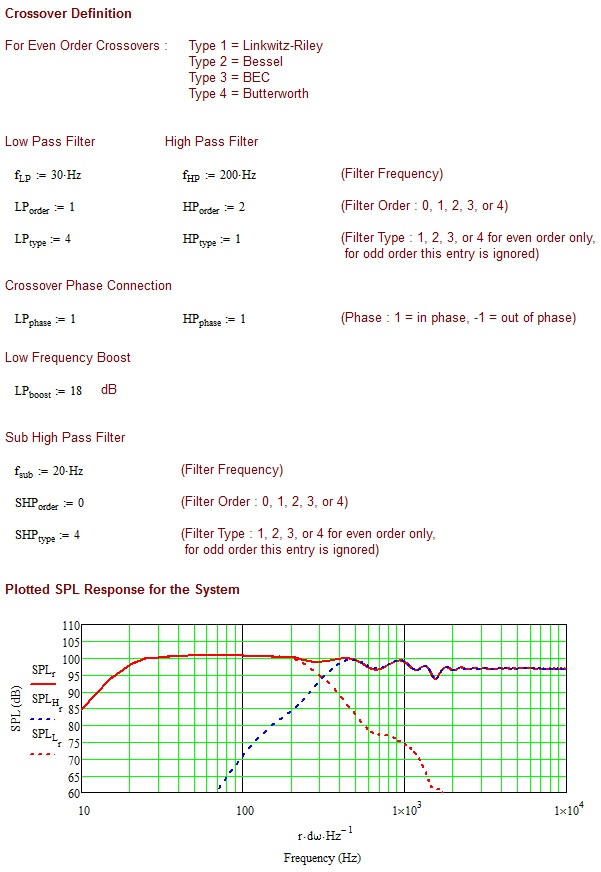
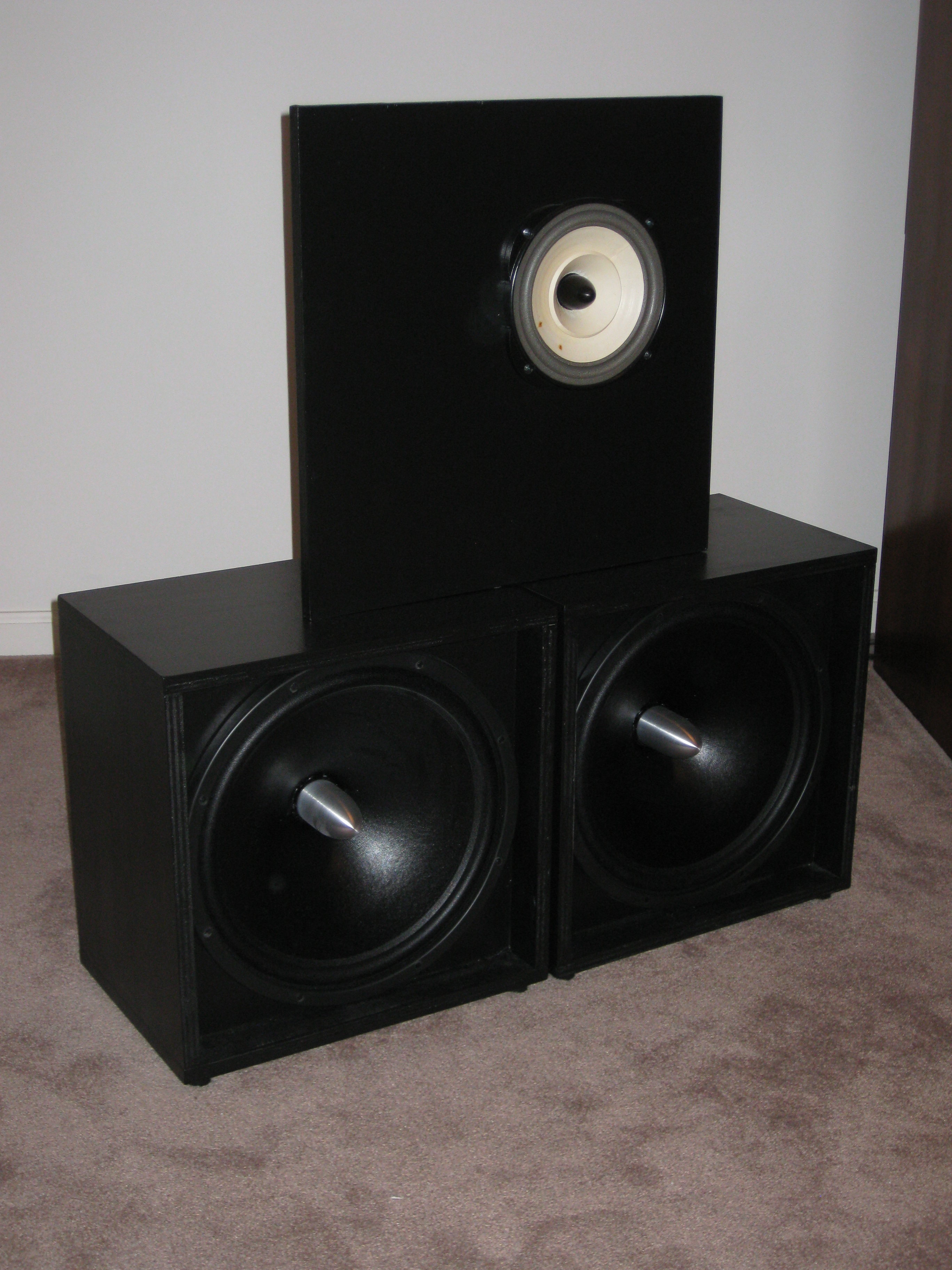
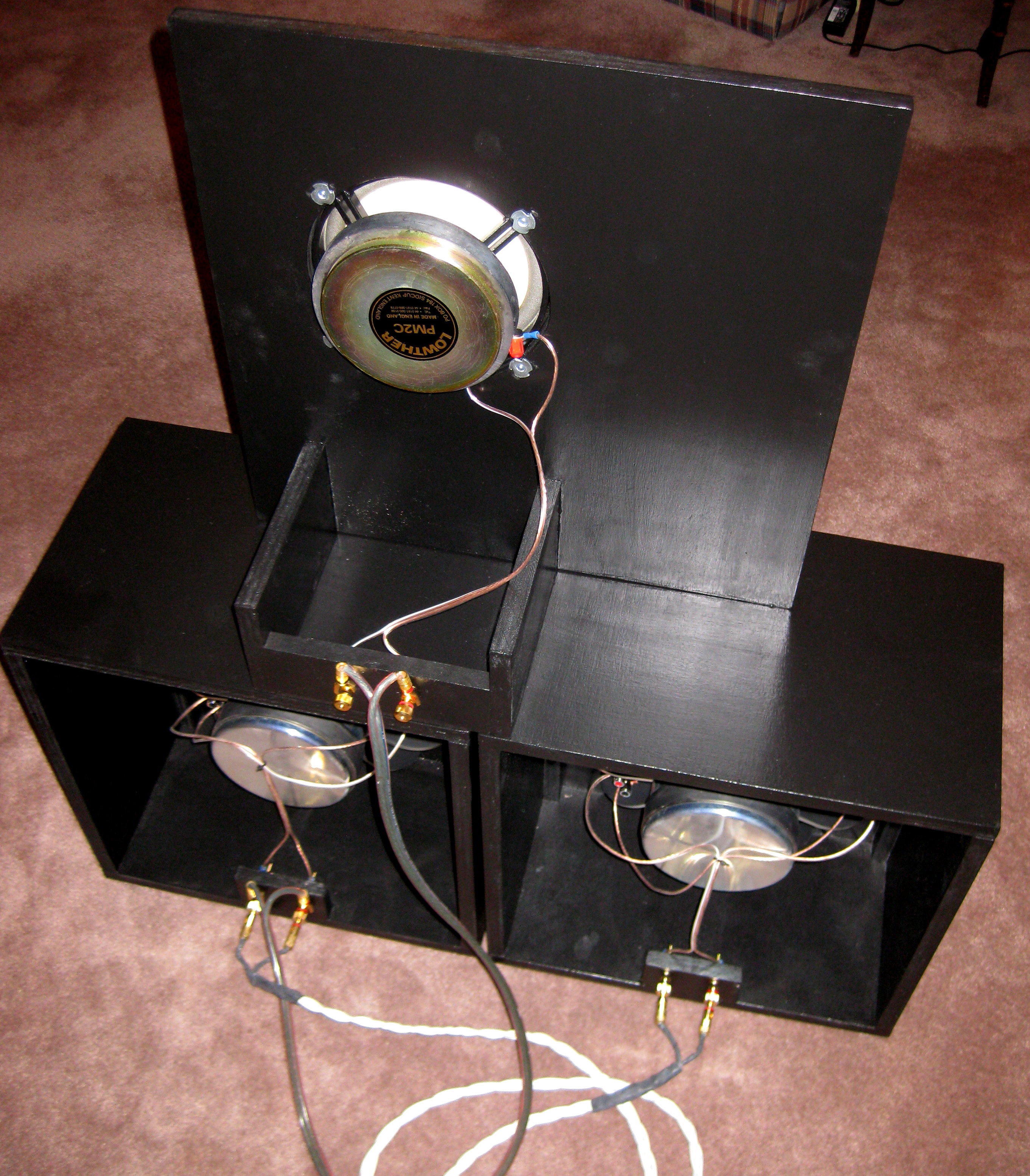
In my opinion using a passive crossover is not really feasible for this design due to the significant peaks in the electrical impedance curves generated by the woofer's low resonant frequency and the large mismatch in the SPL/W/m values between the pair of Acoustic Elegance woofers and the Lowther PM2C full range driver. My preamp is the Rotel RC-1090, with an RT-1080 tuner, driving a pair of Rotel RB-1080 200 watt per channel amps. A dBx Driverack PA performs the active crossover duties and has worked flawlessly for the past 8+ years. I have to admit I had an immediate attraction to the dBx active crossover having owned a few original dBx signal processor products that still function perfectly 25 years later. Probably not the same dBx company, but the name brings back many good memories. Finally, I purchased enough reasonably priced XLR cables from an e-Bay seller to connect all of this hardware together.
To assess the system's performance, the Omnimic measurement software was used to produce a variety of SPL curves with the speakers set-up in my listening room. Measurements were made of the SPL response at the listening position and also the more tradition one meter distance on the axis of the Lowther full range driver. These measurements include the room boundary reflections so they are not as smooth looking as the MathCad worksheet design calculations.
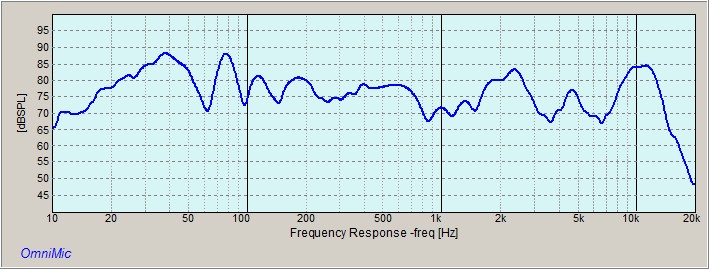
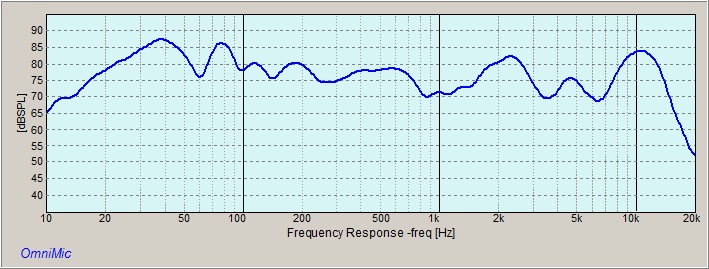
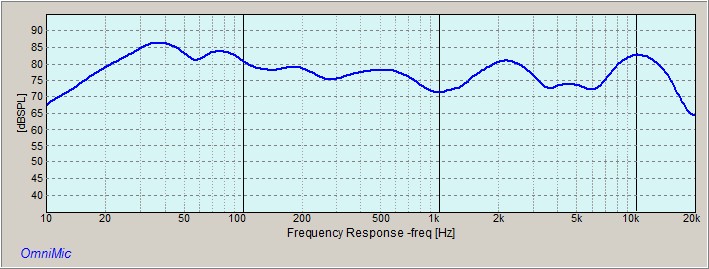
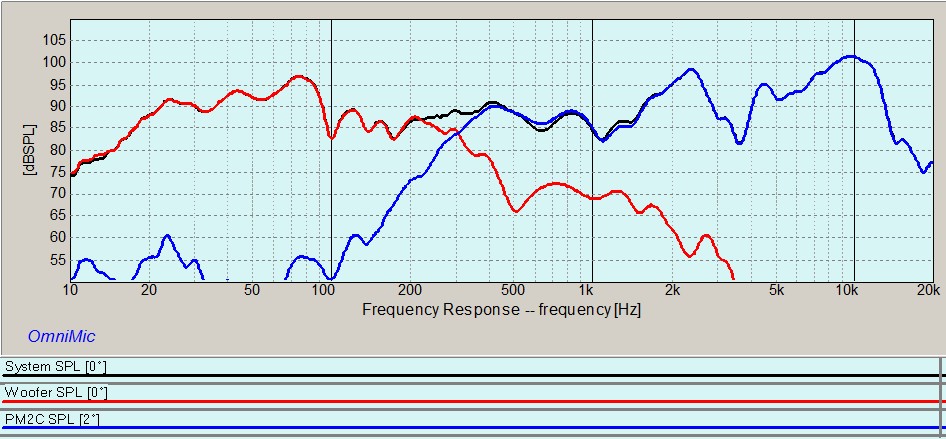
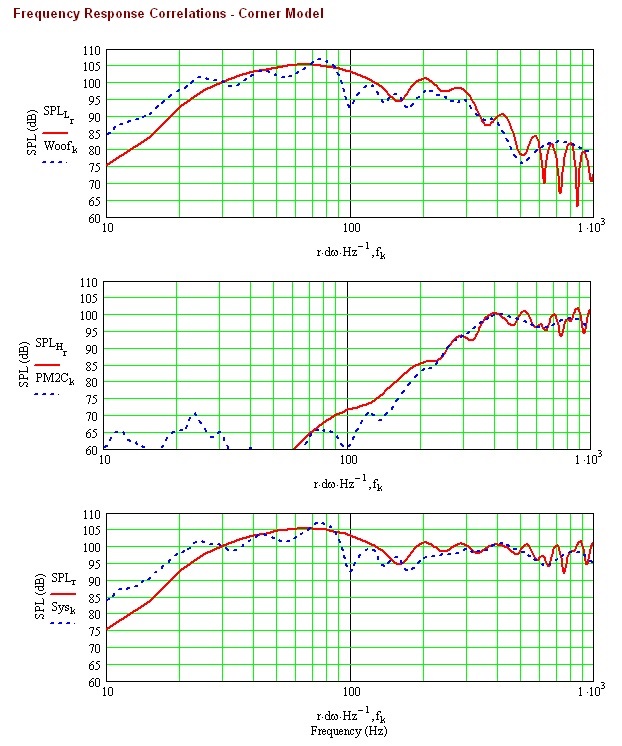
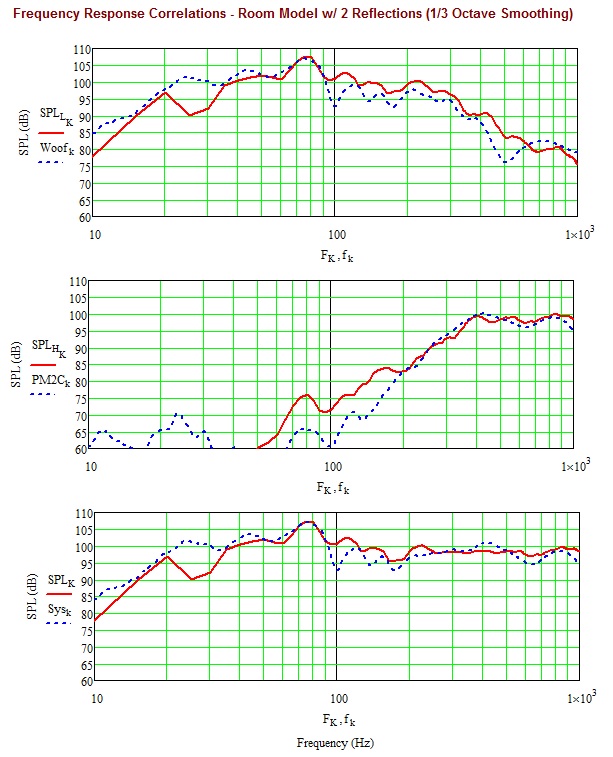
The bottom line for every speaker system is always the sound. These speakers produce a very large sound stage with excellent dynamics. By having such a large woofer cone surface area, the reproduction of a drum solo is getting closer to feeling and hearing the drummer. The bass is not overwhelming or boomy on any recording I have tried to date. The bass response is tight and in proportion to the Lowther mid range and high end SPL response. Once the crossover slopes and frequencies, along with the amount of bass boost, have been dialed in to mate with the room the two drivers mesh seamlessly.
Open baffle bass is different from a boxed enclosure, there is no dominant one note resonant response sometimes heard in boxed designs. Instead the H frames have the capability to reproduce different bass notes clearly and distinctly. This nonresonant bass reproduction makes it easy to distinquish between a string bass pluck and a drum strike. At the same time, these speakers can shake the house if required when playing the 1812 Overture or Micky Hart's Temple Caves for example. Yet they still generate an effortless reproduction of an up-right acoustic bass in small group jazz recordings with precise imaging that I really enjoy.
One of the interesting things I have noticed in the past with this type of driver combination is that the driver cones barely moved even at very loud volume levels. You have to touch each driver to convince yourself it is connected and contributing to the system SPL output. This minimal deflection of the four bass drivers has to help reduce distortion from the woofers. At the same time removing the bass duty from the Lowthers greatly reduces cone motion cleaning up the mid range performance. The full range driver sound is retained with the four woofers handling output below 300 Hz and having all the drivers correctly integration at the crossover frequency.
However nothing is perfect in audio and the Lowther OB / Acoustic Elegance H frame combination does have a couple of problem areas that I am not sure continued tweaking will ever improve. For the acoustic jazz I listen to most, the system performs very well. But large scale complex classical music can get a little garbled / confused and even slightly harsh at times if the recording is particularly dense. A second down side is that poorly recorded material really sounds poorly recorded, the system is not very forgiving. However, on the other side of the coin really well recorded material sounds great. Even with these slight problems I am still enjoying this design and combination of drivers and will use it as my reference system for the foreseeable future.
It will be difficult for upcoming speaker builds to perform at this level.